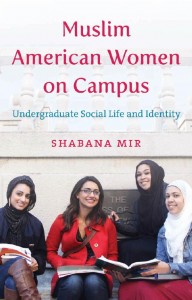Let’s begin with the title. “Muslim women in U.S.” makes it sound like all Muslim women come from elsewhere. How about “American Muslim women”? But that wouldn’t fit with the message writer Ruth Ravve is sending: There’s a strict divide between Americanness (what with its “Western freedoms”) and Muslimness (what with its “Islamic culture”). Note the contrast: freedom vs. culture. And then there’s “struggle.” The headline decisively concludes that this clash between the vague Western freedoms and the monolithic Islamic culture is something Muslim women struggle with.
Let’s move on to the first sentence:
Ravve effectively sets the scene. Message: There’s an impending Muslim takeover. Large Arab population. That frightening call to prayer — in scare quotes, too — the same one that documentaries play behind behind about the Taliban or Al-Qaida. It all sounds like the Middle East. But no! This is America. Which, Ravve presumes, makes the notable Arab and Muslim presence a problem.
In the fourth paragraph, Ravve writes,
Message 1: America = good. Muslims = bad. Notice the quotations attributed to generalized groups like “Muslim women,” not specific individuals.
Message 2: There exists a clear, undisputed idea of what makes a “good Muslim woman,” recognized by Muslims around the world — because every culture that involves Islam has the exact same values, ideals, and interpretation of Islam.
Immediately upon introducing her first specific source, Ravve describes her clothing: “a traditional two-piece suit and a Muslim headscarf, called a hijab. The scarf covers her hair and tightly frames her face. She says the hijab was designed as a way to honor women in Islam, by concealing their beauty.”
Message: The hijab is tight and restricting. It serves to conceal beauty. This is what Islam does: restrict and conceal.
But the oh-so-tired discussion of hijab is not the only overused tactic Ravve employs. She also makes references to the most extreme examples of treatment of women in Muslim countries. She writes,
If Ravve wants to draw a contrast between the United States and a “Muslim country,” Saudi Arabia is the perfect example to point to — its restrictions on women are so extreme they’re not paralleled by any other country. This, however, makes it not terribly reflective of the entire Muslim world. What percentage of women in Dearborn are actually from Saudi Arabia? Not the majority, I’d assume — especially if they can’t get passports. According to the U.S. Census (2000,) the major nationalities among Arab-Americans are Iraqi, Lebanese, Egyptian, Palestinian, Syrian, and Yemeni. Ravve’s second example is also extreme. These “parts of Pakistan and Afghanistan” are presumably those under Taliban influence, which is not the experience of most of the immigrant women Ravve is discussing. Notice that none of her sources say, “When I lived in Afghanistan…” or “When I was in Saudi Arabia…”, much less follow it up with “I couldn’t leave the house” or “I couldn’t legally drive.” The reference to Saudi Arabia and parts of Pakistan and Afghanistan does not actually relate to Ravve’s story, but it does convey a message.
Message: The most extreme examples of repression of women in Muslim countries are representative of the entire Muslim world. Specifically, Muslim women can’t drive until they get to America.
Ravve keeps stressing the idea that Islam and U.S. are extremely different from each other. She writes,
Message: Islam and America are different. This is because the U.S. is full of opportunities, and Islam is very restrictive.
Ravve quotes a woman giving one interpretation of Islam:
Ravve fails to mention that certainly not all Muslims follow this interpretation.
Message: Islam bans music. (Not “Some interpretations of Islam ban music.”)
Ravve consistently presents one interpretation of Islam as what “Islam says,” using only one source to back up her claim. She writes,
Who are these “Islamic leaders”? Ravve does not follow this up with a quote from an Islamic leader, so we have to take her on her word. The quote that follows is from Umia Mustafa, “who moved here from Pakistan 10 years ago, after her parents arranged her marriage to a Pakistani man already living here.” I guess that qualifies her to speak for all Muslims? Throughout the article, Ravve attributes claims about Islam to “Islamic leaders,” but she never mentions who these leaders are.
Also note the contrast Ravve draws between the illegal status of polygamy in the U.S. and the claim that men are the head of the household. What’s the contradiction? Monogamy certainly doesn’t eliminate patriarchy, but the message here is that in America, the man is never the head of the household, that this idea is reserved to Muslims. Ravve quotes Mustafa describing the authority of her husband, as though this only happens in Muslim marriages.
Ravve uses an indirect quote from Mustafa to claim that in Islam, “no matter where it’s practiced, there’s no question who is in charge.”
Message: Muslims don’t respect women. Even if they live in America. You should be worried.
To make the message even clearer, Ravve blatantly warns that “clashes of culture can have deadly consequence,” pointing to the murder of Aasiya Hassan, making the wild jump that the horrific incident occurred due to some “culture clash,” rather than as a brutal act of domestic violence.
She quotes a woman whose qualification to speak on behalf of all Muslims is that she was born in Yemen:
“The typical Muslim man, they always are very overprotective, they’re very controlling over the women. They’re not allowed to do this, they’re not allowed to do that,” says 23-year-old Fai Oman, who was born in Yemen.
Message: Being controlling and overprotective is part of being a Muslim man. And women should watch out — these controlling Muslim men might kill them.
Notice that Ravve doesn’t interview a single man in her article — although a quote on the role of women from one of those controlling Muslim husbands she alludes would help her argument. Perhaps she was afraid of culture clash resulting in “deadly consequence”?
Ravve uses the cliché of an oppressed Muslim woman saved by “the West”:
She [Oman] says she feels lucky to be living in the West because she has more freedom and security than she would have in her home country.
Taking on Western viewpoints and a less traditional look makes Oman stand out in the typical female Muslim community. She dresses in jeans and a low-cut sweater. Her dark hair is highlighted with blonde streaks, and her eyes are colored with bright blue shadow.
Again, Ravve focuses on appearance to make a point about Muslim women. According to Ravve, jeans, a low-cut sweater, blond streaks, and eyeshadow make Oman “stand out” in the “typical female Muslim community.” What is that “typical” community? Because jeans are ubiquitous, and the other items aren’t rarities either. But Ravve makes these details of Oman’s appearance into symbols of her acceptance of American values. (A concept as vague as “Western viewpoints” — whatever those are.)
In painting Oman as a clash against the conservative, misogynist Islam described, Ravve references the nameless “Islamic leaders” again to show the threat of Islam:
Ravve quotes another woman, Sakainah Faleh, who is not only a Yemen native but also a “teacher who tutors young Muslim girls in the proper ways of Islam.” It’s unclear what these “proper ways of Islam” are. From the rest of the article, I expect we’re supposed to think oppressed, controlled, music-free women.
Faleh’s quote itself is vague, and it’s not clear what source Faleh is actually referring to. She says, “It does worry me because it’s improper behavior [that] does lead to … harm to the female.” Is the “improper behavior” Oman’s hair, clothes, and “Western viewpoints”? If so, how does Faleh know Oman? Some more context would make the quote clearer, but perhaps it wouldn’t fit in so nicely after the description of Oman.
The story ends on a better note than the beginning, but it’s still problematic. Ravve quotes a “Muslim leader” (no actual title) from CAIR:
Each comes to the United States with her own versions of cultural and religious practices, she adds.
“Just like America is a melting pot for people from all over the world, it is a melting pot for Muslims from all over the world,” said Aharif. “It is such a diverse community.”
I’m guessing Aharif meant to challenge Ravve’s perception of Islam as a monolithic culture. However, Ravve’s placement of the quote ends up giving credit to America.
Message: Islam is a threat to women, but American culture will prevail.











